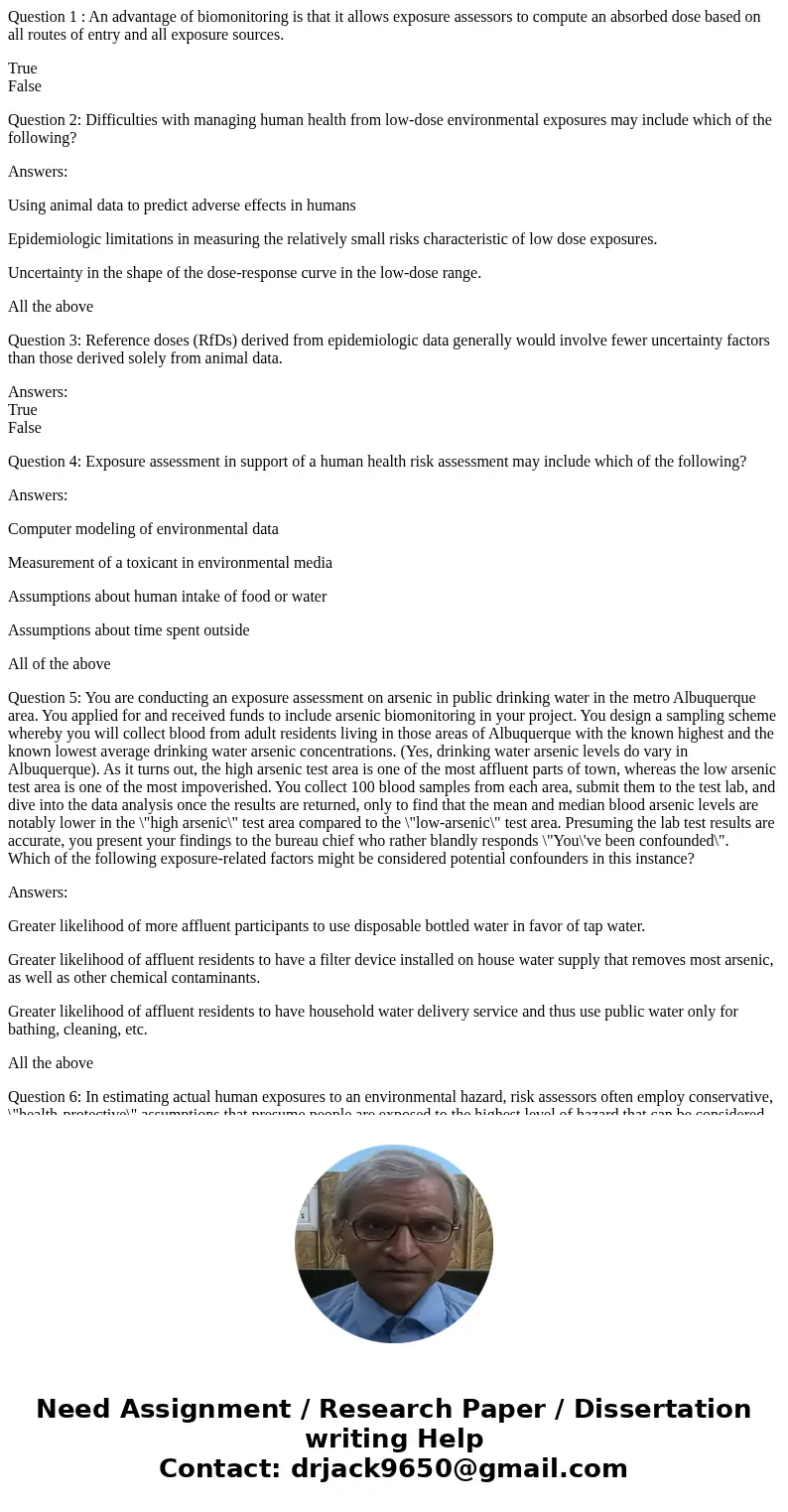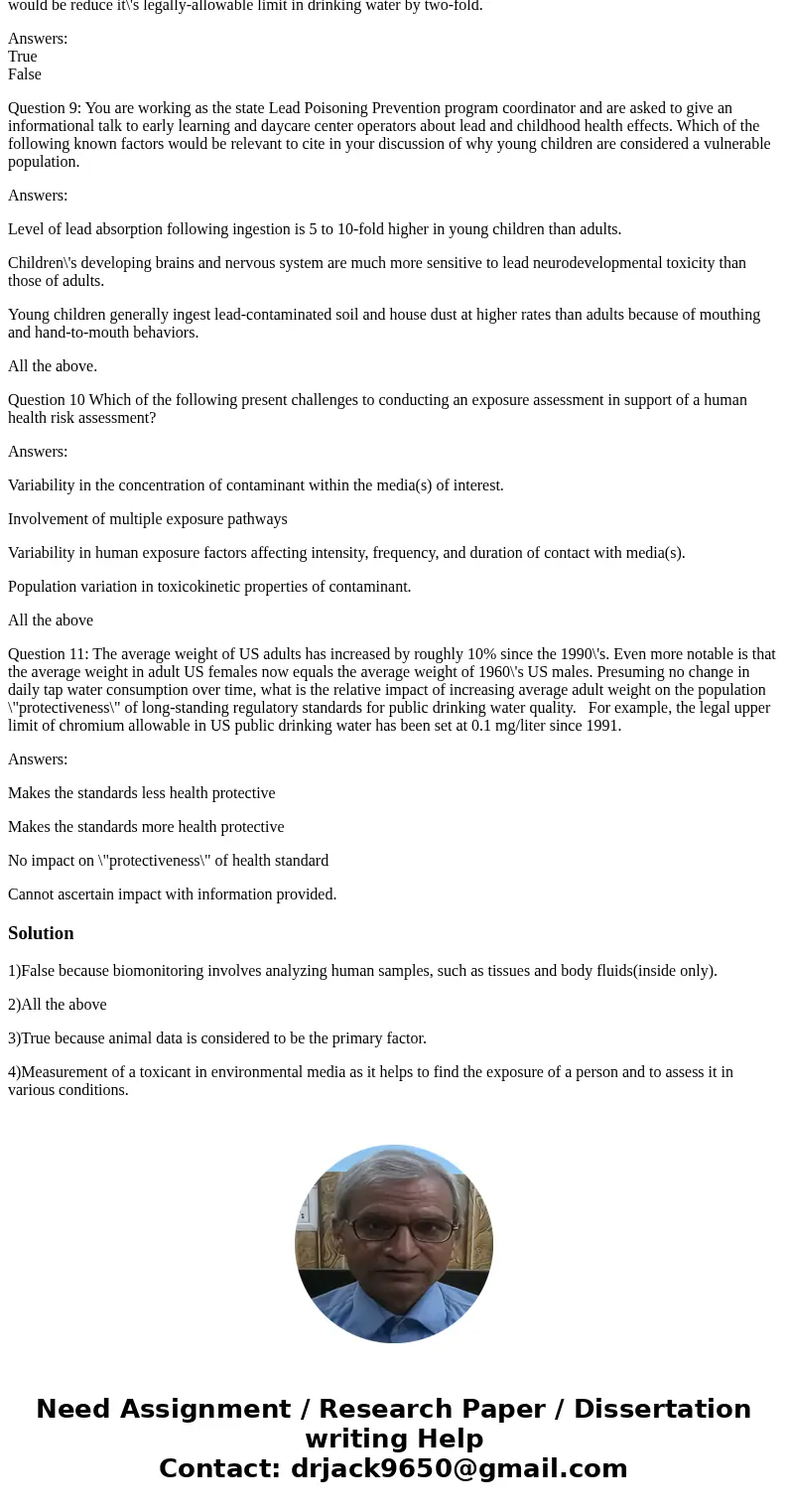Question 1 An advantage of biomonitoring is that it allows
Question 1 : An advantage of biomonitoring is that it allows exposure assessors to compute an absorbed dose based on all routes of entry and all exposure sources.
True
False
Question 2: Difficulties with managing human health from low-dose environmental exposures may include which of the following?
Answers:
Using animal data to predict adverse effects in humans
Epidemiologic limitations in measuring the relatively small risks characteristic of low dose exposures.
Uncertainty in the shape of the dose-response curve in the low-dose range.
All the above
Question 3: Reference doses (RfDs) derived from epidemiologic data generally would involve fewer uncertainty factors than those derived solely from animal data.
Answers:
True
False
Question 4: Exposure assessment in support of a human health risk assessment may include which of the following?
Answers:
Computer modeling of environmental data
Measurement of a toxicant in environmental media
Assumptions about human intake of food or water
Assumptions about time spent outside
All of the above
Question 5: You are conducting an exposure assessment on arsenic in public drinking water in the metro Albuquerque area. You applied for and received funds to include arsenic biomonitoring in your project. You design a sampling scheme whereby you will collect blood from adult residents living in those areas of Albuquerque with the known highest and the known lowest average drinking water arsenic concentrations. (Yes, drinking water arsenic levels do vary in Albuquerque). As it turns out, the high arsenic test area is one of the most affluent parts of town, whereas the low arsenic test area is one of the most impoverished. You collect 100 blood samples from each area, submit them to the test lab, and dive into the data analysis once the results are returned, only to find that the mean and median blood arsenic levels are notably lower in the \"high arsenic\" test area compared to the \"low-arsenic\" test area. Presuming the lab test results are accurate, you present your findings to the bureau chief who rather blandly responds \"You\'ve been confounded\". Which of the following exposure-related factors might be considered potential confounders in this instance?
Answers:
Greater likelihood of more affluent participants to use disposable bottled water in favor of tap water.
Greater likelihood of affluent residents to have a filter device installed on house water supply that removes most arsenic, as well as other chemical contaminants.
Greater likelihood of affluent residents to have household water delivery service and thus use public water only for bathing, cleaning, etc.
All the above
Question 6: In estimating actual human exposures to an environmental hazard, risk assessors often employ conservative, \"health-protective\" assumptions that presume people are exposed to the highest level of hazard that can be considered credible.
Answers:
True
False
Question 7: FDA surveys of mercury levels in seafood represent which component of the human health risk assessment process?
Answers:
Hazard identification
Dose-response assessment
Exposure assessment
None of the above
Question 8 New animal toxicity data has recently become available that strongly indicates the Reference Dose (RfD) for a regulated chemical found in drinking water should be decreased by two-fold in order to be protective of public health. One option regulators would have to maintain the prevailing level of population health protection for this chemical would be reduce it\'s legally-allowable limit in drinking water by two-fold.
Answers:
True
False
Question 9: You are working as the state Lead Poisoning Prevention program coordinator and are asked to give an informational talk to early learning and daycare center operators about lead and childhood health effects. Which of the following known factors would be relevant to cite in your discussion of why young children are considered a vulnerable population.
Answers:
Level of lead absorption following ingestion is 5 to 10-fold higher in young children than adults.
Children\'s developing brains and nervous system are much more sensitive to lead neurodevelopmental toxicity than those of adults.
Young children generally ingest lead-contaminated soil and house dust at higher rates than adults because of mouthing and hand-to-mouth behaviors.
All the above.
Question 10 Which of the following present challenges to conducting an exposure assessment in support of a human health risk assessment?
Answers:
Variability in the concentration of contaminant within the media(s) of interest.
Involvement of multiple exposure pathways
Variability in human exposure factors affecting intensity, frequency, and duration of contact with media(s).
Population variation in toxicokinetic properties of contaminant.
All the above
Question 11: The average weight of US adults has increased by roughly 10% since the 1990\'s. Even more notable is that the average weight in adult US females now equals the average weight of 1960\'s US males. Presuming no change in daily tap water consumption over time, what is the relative impact of increasing average adult weight on the population \"protectiveness\" of long-standing regulatory standards for public drinking water quality. For example, the legal upper limit of chromium allowable in US public drinking water has been set at 0.1 mg/liter since 1991.
Answers:
Makes the standards less health protective
Makes the standards more health protective
No impact on \"protectiveness\" of health standard
Cannot ascertain impact with information provided.
Solution
1)False because biomonitoring involves analyzing human samples, such as tissues and body fluids(inside only).
2)All the above
3)True because animal data is considered to be the primary factor.
4)Measurement of a toxicant in environmental media as it helps to find the exposure of a person and to assess it in various conditions.



 Homework Sourse
Homework Sourse